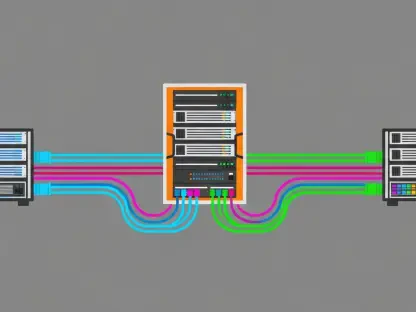Generative Artificial Intelligence (Generative AI) is making waves in the field of data visualization, particularly within data analytics. This transformative technology is not just changing how data is presented but also enhancing the entire process of data analysis, offering numerous benefits while also presenting some challenges that need to be addressed for successful implementation. As businesses and organizations across various sectors increasingly depend on data to drive decision-making, the role of Generative AI becomes even more critical. The ability to turn raw data into meaningful visual insights can significantly impact how strategies are formulated and executed, making Generative AI an invaluable asset in the modern analytics toolkit.
The Power of Data Augmentation
Generative AI enhances the efficiency of machine learning algorithms by generating additional data that closely resembles the initial dataset. This approach increases the variety and reliability of the dataset, ultimately improving predictive models. For example, in the medical field, Generative AI can generate artificial patient records to bolster small datasets, facilitating more robust training for predictive models in diagnosing diseases. This leads to improved patient care by enhancing the precision of diagnostic instruments. The ability to create synthetic data that mirrors real-world scenarios allows businesses to overcome the limitations of small datasets.
Moreover, data augmentation through Generative AI allows companies to train their models more effectively, leading to better performance and more accurate predictions. This capability is particularly valuable in industries where data collection is challenging or expensive. By expanding datasets with artificially generated data, companies can push the boundaries of what is possible, improving the functionality and accuracy of their predictive algorithms. This is particularly important in fields such as retail, where customer behavior data can be sparse or biased, but augmented data helps in creating a more comprehensive overview.
Streamlining Anomaly Detection
Recognizing irregularities or anomalies within data is crucial for establishing accurate patterns and distributions. Generative AI significantly reduces the manual workload required for this task by effortlessly pinpointing anomalies or outliers within the data. This ability guarantees that data visualization accurately reflects the underlying patterns, leading to more reliable insights and better decision-making. Anomaly detection powered by Generative AI is especially beneficial in sectors such as finance and cybersecurity, where identifying unusual patterns can prevent fraud and security breaches.
Automating the anomaly detection process allows organizations to respond more quickly to potential threats and maintain the integrity of their data. For instance, in finance, Generative AI can flag unusual transaction patterns that could indicate fraudulent activity, enabling faster intervention. Similarly, in cybersecurity, AI-driven anomaly detection can identify unusual network activities that might signal a breach, allowing for quicker and more effective responses. These capabilities not only enhance security but also free up human analysts to focus on more strategic and complex tasks.
Enhancing Data Synthesis
Generative AI enables the creation of diverse scenarios to examine various outcomes or trends in data visualization. This involves generating specific instances or entire datasets that adhere to the statistical framework of the original data. This approach allows for comprehensive examination and simulation of different scenarios, improving the predictive accuracy of models. For instance, in climate science, Generative AI can simulate various climate conditions and their potential impacts. This aids researchers and policymakers in making informed decisions about climate change mitigation and adaptation strategies.
The ability to synthesize data using Generative AI helps open up new possibilities for exploring complex systems and predicting future trends. Industries such as finance and healthcare benefit from this capability by simulating economic conditions or disease spread scenarios, respectively. This level of predictive modeling allows for better preparation and more strategic planning, mitigating risks and leveraging opportunities more effectively. Through synthetic data generation, businesses can test multiple scenarios and outcomes without the need for real-world data, thus enhancing their ability to strategize and execute plans.
Simplifying Code Generation
Generative AI simplifies the often complex task of crafting intricate code or functions for Business Intelligence (BI) developers. For instance, conversational interfaces like ChatGPT or BART can generate the necessary Data Analysis Expressions (DAX) query for Power BI. This streamlines the process for BI developers, enhancing efficiency and reducing the complexity of code generation. By automating code generation, Generative AI allows developers to focus on higher-level tasks, such as interpreting results and making strategic decisions.
This not only speeds up the development process but also reduces the likelihood of errors, leading to more reliable and accurate data visualizations. Developers can benefit greatly from automation in repetitive coding tasks, freeing up valuable time that can be spent on developing innovative solutions and analyzing the data at hand. By leveraging AI for code generation, organizations can ensure that their data pipelines and visualization tools are robust and scalable, maintaining high accuracy and reliability levels in their data-driven decisions.
Improving Metadata Analysis
Each BI system possesses unique metadata or audit data that can be scrutinized using natural language queries (NLQ). This process aids in managing the BI system by examining report usage, tracing data lineage, and reviewing metadata. It helps pinpoint outdated, redundant, or unused reports, improving the rationalization of reports and overall system efficiency. Metadata analysis powered by Generative AI provides valuable insights into how data is being utilized within an organization.
By understanding usage patterns and identifying inefficiencies, businesses can optimize their data management practices and ensure that their BI systems operate at peak performance. Effective metadata analysis is crucial for organizations to maintain the relevance and accuracy of their reports. By leveraging Generative AI, data administrators can keep their systems streamlined and functional, ensuring that only the most pertinent information is used in decision-making processes, thus eliminating data bloat and enhancing the overall efficiency of data operations.
Addressing Data Imputation
Generative AI leverages patterns and distributions present in the existing data to fill in missing values, leading to more thorough visual representations and enhancing the understanding of the dataset. By seamlessly imputing missing data, Generative AI ensures that the visualization is comprehensive and reliable. This process is particularly crucial in fields such as healthcare and finance, where incomplete data can lead to incorrect conclusions and poor decision-making. Ensuring data completeness is vital for maintaining the integrity and reliability of any analytical model.
By filling in the gaps, Generative AI helps organizations maintain the integrity of their data and make more informed decisions based on complete and accurate information. In healthcare, for instance, data imputation can help improve patient records and treatment plans, leading to better healthcare outcomes. In finance, it ensures that analyses and predictions are based on comprehensive data, reducing the risk of errors and enhancing the precision of financial forecasts and strategies. This not only improves operational efficiency but also builds trust in data-driven decision-making processes.
Facilitating Data Discovery and Insights
Generative AI provides a user-friendly interface that operates through natural language, offering a straightforward way to engage with data. This enhancement in data discovery and insights enables users to interact with complex datasets in an intuitive manner. The ability to uncover insights and patterns that would be difficult to identify through traditional data analysis methods democratizes data analysis, making it accessible to a wider range of users.
This empowers employees at all levels of an organization to explore data, generate insights, and contribute actively to data-driven decision-making processes. For instance, marketing teams can utilize intuitive AI tools to analyze consumer behavior without needing deep technical expertise. Similarly, product managers can explore sales data to identify emerging trends and areas for improvement. By making sophisticated data analysis tools accessible to non-specialists, organizations can foster a more data-centric culture and drive innovation and growth across all departments.
Enhancing Storytelling and Narratives
Generative AI enhances data visualization by adding textual explanations, captions, or stories alongside visual elements like charts, maps, or graphs. This approach improves the comprehensibility of data visualizations, making them more engaging and informative. The integration of narrative elements ensures that complex insights are communicated effectively to a broader audience, making the data not only more accessible but also more actionable.
By combining visual and textual elements, Generative AI helps organizations tell compelling stories through their data. For example, a company could illustrate its year-over-year performance with charts while highlighting key achievements and areas of concern through accompanying text. This dual approach ensures that stakeholders get a clear and comprehensive picture of the data, leading to better understanding and more informed decision-making. Effective storytelling is critical in turning raw data into actionable insights, and Generative AI plays a significant role in making this possible.
Conclusion
Generative Artificial Intelligence (Generative AI) is making a significant impact in data visualization, especially within the realm of data analytics. This innovative technology is transforming not only the way data is presented but also enhancing the entire data analysis process. It offers numerous benefits, although there are also some challenges that need to be overcome to ensure its successful implementation.
In today’s data-driven world, businesses and organizations across various sectors heavily rely on data to inform their decision-making processes. Here, the role of Generative AI becomes increasingly vital. The technology’s ability to convert raw data into meaningful visual insights can drastically influence the development and execution of strategies. This makes Generative AI an indispensable component in the modern data analytics toolkit. By creating more intuitive and detailed visual representations of complex data sets, Generative AI enables analysts and decision-makers to identify patterns, trends, and anomalies with greater ease and accuracy.
Moreover, Generative AI can automate and streamline many aspects of the data analysis process. This innovation not only saves time but also reduces the potential for human error. As we continue to move towards a more data-centric future, the importance of effectively leveraging Generative AI will only grow. However, to fully realize its potential, businesses must also address challenges such as data privacy concerns, the need for high-quality data, and ensuring their teams are adequately trained to use this advanced technology.









